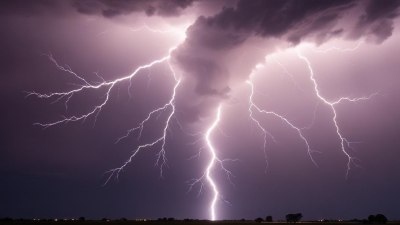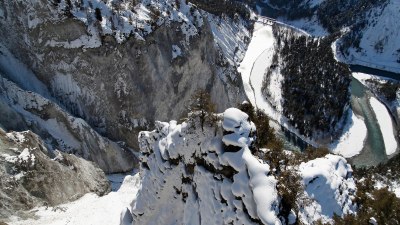The Secret Life of Lightning What Really Happens Inside a Bolt
Discover the fascinating science behind lightning, its formation, and its incredible power in just a few words.

This image was created with the assistance of Freepik
Lightning is one of nature's most amazing phenomena, captivating us with its brilliance and power. To truly appreciate this awe-inspiring display, we must delve deep into the science behind lightning, exploring what really happens inside a bolt. This article aims to unveil the intricacies of this atmospheric marvel, unraveling the secrets that lie within each flash of lightning.
The Basics of Lightning
Lightning is essentially a massive electrical discharge that occurs between charged regions within clouds, or between clouds and the ground. This phenomenon is most commonly associated with thunderstorms, although it can happen during volcanic eruptions or even when conditions are just right in clear skies. Cloud-to-ground lightning is the most recognized form, creating spectacular displays that can light up the sky.
How Lightning Forms
At the heart of lightning formation is the process of charge separation within a storm cloud. Thunderstorms develop strong updrafts, causing ice crystals and water droplets to collide. These collisions lead to the transfer of electrons from one particle to another, resulting in a buildup of electrical charges. Typically, the top of the cloud becomes positively charged while the lower part becomes negatively charged. This charge separation creates an electric field that strengthens until it eventually overcomes the insulating properties of the air, resulting in a lightning bolt.
The Flash of Lightning
The moment the electrical potential becomes strong enough, a discharge occurs. This process begins with a step leader, a series of ionized paths that extend downward from the cloud in a zigzag pattern. As the step leader approaches the ground, the electric field intensifies, inducing a positive charge on the surface, particularly on tall structures or objects. Once the step leader connects with the upward return stroke from the ground, a complete circuit is formed, and the main lightning bolt flashes downwards at speeds of up to 60,000 miles per hour.
The Components of Lightning
A typical lightning bolt consists of three components: the stepped leader, the return stroke, and the dart leader. The stepped leader is a faint and rapid sequence of ionized air that extends towards the ground, while the return stroke is the bright flash we see, as it travels rapidly upward along the channel formed by the stepped leader. Finally, the dart leader follows the same path, reinvigorating the channel with further discharges that produce multiple flashes.
The Temperature of Lightning
One of the most astonishing aspects of lightning is its temperature. A typical lightning bolt can reach temperatures of around 30,000 Kelvin, which is five times hotter than the surface of the sun! This extreme heat causes the surrounding air to rapidly expand, resulting in the thunder we hear moments later. The sudden expansion leads to a shock wave that we perceive as a loud clap or rumble, depending on the distance of the strike.
Colors of Lightning
While we often associate lightning with bright white flashes, the color of lightning can vary based on several factors. Atmospheric conditions, humidity, and the presence of particles such as dust or rain can alter its hue. Lightning can appear blue, purple, or even yellow and orange, each color revealing details about the conditions at the moment of the strike.
Different Types of Lightning
Lightning manifests in various forms, each with distinct characteristics. The most common types include:
- Cloud-to-Ground Lightning: This is the most well-known type of lightning, where discharge occurs from the cloud to the earth.
- Intra-Cloud Lightning: These flashes occur within a single cloud, typically created by interactions between differently charged regions.
- Inter-Cloud Lightning: This type arises when discharge occurs between two separate clouds.
- Ground-to-Cloud Lightning: A less common phenomenon, this occurs when an upward charge from the ground meets a cloud's negatively charged region.
Lightning's Role in Nature
Lightning plays a crucial role in maintaining the Earth's ecological balance. It assists in the nitrogen fixation process, which is essential for healthy plant growth. When lightning strikes, it heats the air, creating nitrogen oxides. These compounds are soluble in rainwater and are delivered to the soil, promoting the nourishment of crops and other vegetation.
The Dangers of Lightning
Despite its beauty, lightning poses significant dangers. Lightning strikes can cause severe injuries and fatalities, as well as damage to property, trees, and infrastructure. According to the National Weather Service, about 20 million lightning strikes occur in the United States each year, causing hundreds of injuries and dozens of fatalities. It is crucial to seek shelter during a thunderstorm to minimize the risk of being struck.
Protective Measures Against Lightning
Safety precautions can be taken to mitigate the risks associated with lightning strikes. When caught outdoors during a storm, it is advisable to move to a low-lying area, avoid open fields, and stay away from tall trees or structures. If indoors, stay away from windows, electrical appliances, and plumbing fixtures, as lightning can travel through these systems.
Lightning Research and Technology
Scientists continue to study lightning to understand its behavior better and improve safety measures. Advances in weather modeling and lightning detection technology have significantly enhanced our capacity to predict thunderstorms and assess the potential risks associated with lightning strikes. The use of remote sensing techniques, satellites, and ground-based sensors provides valuable data for real-time monitoring and forecasting.
Mythology and Culture
Throughout history, lightning has held a significant place in various cultures and mythologies. In ancient societies, it was often seen as a manifestation of divine power, represented by gods such as Zeus in Greek mythology and Thor in Norse mythology. Such associations highlight humanity's long-standing fascination with lightning and its perceived connection to the forces of nature.
The Future of Lightning Research
The future of lightning research looks promising, with new technologies enhancing our understanding of this complex phenomenon. Ongoing studies focus on lightning's role in climate change, its effects on the environment, and how it influences atmospheric chemistry. As we delve deeper into the secrets of lightning, we inch closer to unraveling the mysteries that have intrigued humans for centuries.
Understanding the secret life of lightning reveals not only the scientific marvel behind each bolt but also highlights its critical importance in nature and the atmosphere. As we continue to explore the enigma that is lightning, we garner not only a deeper appreciation for its beauty but also the knowledge necessary to safeguard ourselves from its potentially dangerous effects. So, the next time the sky lights up with a dazzling display, take a moment to marvel at the incredible science behind it.











